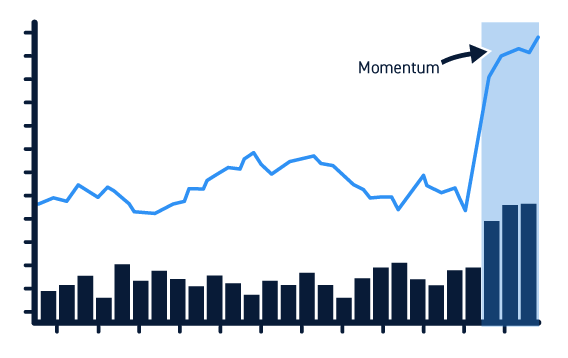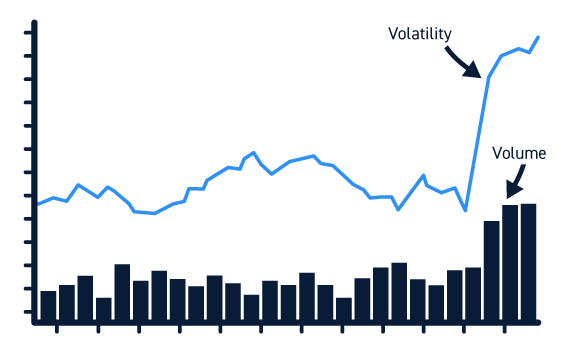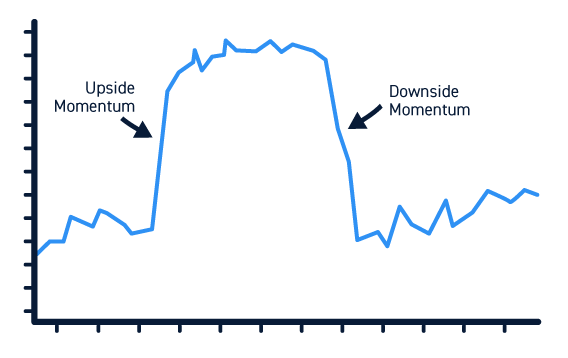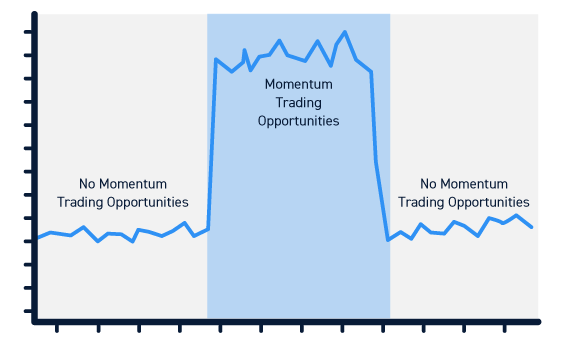Momentum stocks offer opportunities for traders to ride a wave of price action for short-term profits. However, to trade momentum stocks successfully, it’s important to recognize momentum early on and know when to exit a trade.
In this guide, we’ll explain what momentum stocks are, how to identify them, and how to approach trading them.
What is Momentum Trading?
Momentum trading is a trading strategy that seeks to profit off of strong directional movements in stocks. Stocks that are trading strongly upward or downward with high volume are said to have momentum.

Momentum trading relies on the idea that directional movements are slow to get started, but can continue at high speed once they get going. During this high-speed phase, traders can enter a position and ride the movement for a profit. When momentum ends, the directional movement fades and the stock can trade sideways or even reverse.
The key to momentum trading is to enter and exit a position before momentum starts to wear off and a potential reversal begins. In short, the goal of momentum trading is to profit from the price action while the momentum is in play, but not to pick the top or bottom of the move.
Key Components of Momentum Stocks
Momentum stocks have two key components: volume and volatility.

When stocks have momentum, they typically trade with higher than average volume. This increased volume reflects unusually high interest in the stock, which is required to sustain a strong directional movement. Importantly, high trading volume also means that there is high liquidity in the stock, making momentum stocks good targets for short-term traders.
Momentum stocks also have high volatility. High volatility is a direct consequence of a strong directional movement and this volatility provides the price action necessary for traders to make a profit. The directional movement of a momentum stock can be highly volatile, with many small ups and downs within the overall trend, or it can be relatively linear.
Other Factors in Momentum Trading
When trading momentum stocks, there are a few important factors to think about.
Long and Short Trades
First, momentum can go in either direction – up or down. That means that momentum traders can take long positions in stocks with bullish momentum or short positions in stocks with bearish momentum.

It’s also possible to mix long and short trades, particularly around the end of a momentum trade. For example, you could enter a long position in a stock with upward momentum. Once momentum begins to fade, you can exit the long position and enter a short position in anticipation of a reversal.
Technical Analysis
Momentum traders largely rely on technical analysis rather than fundamental analysis. That’s because momentum is short-term and sudden. It’s driven to a large extent by traders piling into a stock rather than by abrupt changes in a company’s valuation. Even when a positive earnings report or other material news is the catalyst for a directional movement, the strength of the ongoing price movement is best monitored using technical indicators.
There are many technical indicators available for monitoring a stock’s momentum, including MACD, RSI, and stochastics etc…
Catalysts
Momentum in a stock is often kicked off by a positive or negative catalyst, such as major news or an earnings report. However, external catalysts aren’t always required to initiate momentum. In some cases, a strong directional movement can start with a technical breakout above a resistance level or with a bounce off a key support level. It can also be triggered by moves in other stocks in like sectors.
Momentum Timeframes
Stocks can experience momentum over timeframes ranging from a few hours to a few months. For active momentum traders, the focus is typically on momentum that occurs over hours or days. Swing traders and momentum investors often focus on directional price movements that unfold over weeks or months.
Goals of Momentum Trading
The goal of momentum trading is to profit from a directional price movement. To be successful, momentum traders need to enter a trade while a stock’s momentum is still accelerating and exit the trade before momentum begins to fade.

When planning momentum trades, it’s important to look for high-probability setups. The stronger and more linear a stock’s momentum, the better. Traders can use technical indicators and volume to gauge the strength of a setup, while also keeping an eye on support and resistance levels.
Traders also need to have risk and reward in mind for every momentum trade. It might make sense to risk a loss of 1% back to a support level if the next band of resistance is 4% higher than a stock’s current price. On the other hand, a momentum trade may not be worth it if the potential loss is 4% and potential gain is only 1-2%. Set clear stop-loss and profit targets for momentum trades before entering positions and adhere to them once you open a trade.
Conclusion
Momentum trading seeks to profit off of strong, short-term directional movements in the price of stocks. Momentum stocks have above-average trading volume and above-average volatility, offering opportunities for traders to ride a wave of price action and get out before conditions change. When trading momentum stocks, be sure to look for high-probability setups and to define stop-loss and profit targets for every trade.






